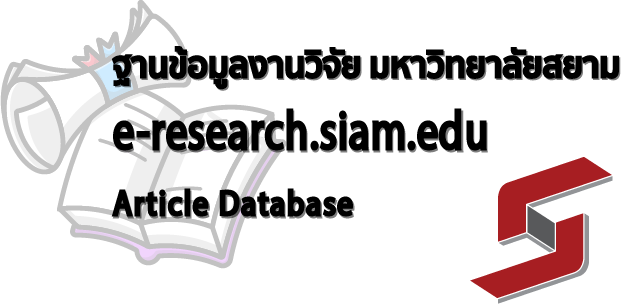- KB Home
- หลักสูตรระดับบัณฑิตศึกษา|Graduate Schools
- หลักสูตรปริญญาเอก|Doctoral Degree
- D.B.A.
- รูปแบบการตลาดอิงการกุศล การสร้างคุณค่าทางการตลาดและต่อการตัดสินใจซื้อผลิตภัณฑ์เพื่อสิ่งแวดล้อม
| หัวข้อวิทยานิพนธ์: Project Title: |
รูปแบบการตลาดอิงการกุศล การสร้างคุณค่าทางการตลาดและต่อการตัดสินใจซื้อผลิตภัณฑ์เพื่อสิ่งแวดล้อม The Marketing Model of Cause Related Value Creation and Environmental Product Purchase Decision Making |
| ชื่อนักศึกษา: Author: |
นางบุษยมาส ชื่นเย็น Mrs. Boosayamas Chuenyen |
| อาจารย์ที่ปรึกษา: Advisor: |
ผู้ช่วยศาสตราจารย์ ดร.ปริญ ลักษิตามาศ Assistant Professor Dr. Prin Laksitamas |
| ระดับการศึกษา: Degree: |
บริหารธุรกิจดุษฎีบัณฑิต (บธ.ด.) Doctor of Business Administration |
| สาขาวิชา: Major: |
การตลาด Marketing |
| คณะ: Faculty: |
บัณฑิตวิทยาลัย Graduate Schools |
| ปีการศึกษา: Academic year: |
2566 2023 |
| Published/แหล่งเผยแพร่: |
utcc2.utcc.ac.th/academicday2023/บทความวารสารปัญญาภิวัฒน์ เรื่อง “รูปแบบการตลาดอิงการกุศล การสร้างคุณค่าทางการตลาดและการตัดสินใจซื้อผลิตภัณฑ์เพื่อสิ่งแวดล้อมในเขตภาคตะวันออกเฉียงเหนือตอนล่าง” ปีที่ 15 ฉบับที่ 3 (กันยายน – ธันวาคม 2566) การประชุมวิชาการและการนำเสนอผลงานวิชาการระดับชาติ IHUSOC III the 3rd International Conference on Humanities and Social Sciences & NIVCMR (the 5th National and International Virtual Conference on Multidisciplinary Research) |
การอ้างอิง|Citation
บุษยมาส ชื่นเย็น. (2566). รูปแบบการตลาดอิงการกุศล การสร้างคุณค่าทางการตลาดและต่อการตัดสินใจซื้อผลิตภัณฑ์เพื่อสิ่งแวดล้อม. (วิทยานิพนธ์ปรัชญาดุษฎีบัณฑิต). กรุงเทพฯ: บัณฑิตวิทยาลัย มหาวิทยาลัยสยาม.
Chuenyen B. (2023). The marketing model of cause related value creation and environmental product purchase decision making. (Doctoral dissertation). Bangkok: Siam University.
บทคัดย่อ
การวิจัยเรื่องรูปแบบการตลาดอิงการกุศล การสร้างคุณค่าทางการตลาดและต่อการตัดสินใจซื้อผลิตภัณฑ์เพื่อสิ่งแวดล้อม เป็นงานวิจัยเชิงปริมาณ โดยมีวัตถุประสงค์ 1) เพื่อศึกษาปัจจัยส่วนบุคคลของผู้บริโภคในการตัดสินใจซื้อผลิตภัณฑ์เพื่อสิ่งแวดล้อม 2) เพื่อศึกษาระดับความคิดเห็นการตลาดอิงการกุศล การสร้างคุณค่าทางการตลาด และต่อการตัดสินใจซื้อผลิตภัณฑ์เพื่อสิ่งแวดล้อม3) เพื่อวิเคราะห์การตลาดอิงการกุศลที่ส่งผลต่อการสร้างคุณค่าทางการตลาดและต่อการตัดสินใจซื้อผลิตภัณฑ์เพื่อสิ่งแวดล้อม และ 4) เพื่อแสวงหารูปแบบการตลาดอิงการกุศล ที่สร้างคุณค่าทางการตลาด และต่อการตัดสินใจซื้อผลิตภัณฑ์เพื่อสิ่งแวดล้อม โดยเก็บรวบรวมข้อมูลจากกลุ่มผู้บริโภค ที่มีประสบการณ์เลือกซื้อผลิตภัณฑ์เพื่อสิ่งแวดล้อม โดยใช้สถิติวิเคราะห์โมเดลสมการโครงสร้าง (SEM-Structural Equation Modeling) จากขนาดกลุ่มตัวอย่างจำนวน 1,000 คน ในเขตภาคตะวันออกเฉียงเหนือตอนล่าง (อีสานใต้) ได้แก่ จังหวัดนครราชสีมา จังหวัดบุรีรัมย์ จังหวัดสุรินทร์ จังหวัดศรีสะเกษ และจังหวัดอุบลราชธานี โปรแกรม AMOS
ผลการวิจัย พบว่า ปัจจัยส่วนบุคคล เป็นเพศหญิง จำนวน 692 คน คิดเป็นร้อยละ 69.20 อายุระหว่าง 18 – 38 ปี จำนวน 685 คน คิดเป็นร้อยละ 68.5 การศึกษาสูงสุดระดับปริญญาตรี จำนวน 556 คน คิดเป็นร้อยละ 55.6 รายได้ส่วนบุคคลต่อเดือน 10,001-20,000 บาท จำนวน 493 คน คิดเป็นร้อยละ 49.3 อาชีพนักศึกษา จำนวน 429 คน คิดเป็นร้อยละ 42.9 ประสบการณ์ที่เกี่ยวข้องกับการใช้ผลิตภัณฑ์เพื่อสิ่งแวดล้อม 1 – 3 ปี จำนวน 567 คน คิดเป็นร้อยละ 56.7 อนึ่งการตัดสินใจซื้อผลิตภัณฑ์เครื่องสำอางที่ทำมาจากวัตถุดิบธรรมชาติ จำนวน 490 คน คิดเป็นร้อยละ 49.0 ผู้บริโภคมีความคิดเห็นการตลาดอิงการกุศลจากประเด็นปัญหาด้านทรัพยากรธรรมชาติ มากที่สุด
2) ระดับความคิดเห็นการตลาดอิงการกุศลคือเรื่องประเด็นปัญหาด้าน ได้แก่ ทรัพยากรธรรมชาติ (ความเสื่อมสภาพดิน น้ำ อากาศ ป่าไม้และแร่ธาตุ) มากที่สุด (x̄ = 4.17) รองลงมาความเสี่ยงต่อชีวิตและทรัพย์สิน (การจลาจล การฆาตกรรม การโจรกรรม และโรคระบาด) (x̄ = 4.1) และสิ่งแวดล้อมทางธรรมชาติ (สัตว์ น้ำท่วม พายุ แผ่นดินไหว/ถล่ม ความแห้งแล้งและความหนาวเย็น) (x̄ = 4.08) ตามลำดับ และระดับความคิดเห็นการสร้างคุณค่าทางเรื่องคุณค่าทางคุณภาพ ได้แก่ ผลิตภัณฑ์เพื่อสิ่งแวดล้อมมีกระบวนการผลิตเป็นไปตามมาตรฐานมากที่สุด (x̄ = 4.13) รองลงมาผลิตภัณฑ์เพื่อสิ่งแวดล้อมสามารถสร้างความพึงพอใจให้ผู้บริโภคยอมรับ
(x̄ = 4.12) และผลิตภัณฑ์เพื่อสิ่งแวดล้อมต้องมีคุณสมบัติหรือสรรพคุณตามที่กล่าวอ้างในการโฆษณา/บรรจุภัณฑ์ (x̄ = 4.11) ตามลำดับ
3) การวิเคราะห์การตลาดอิงการกุศลที่ส่งผลต่อการสร้างคุณค่าทางการตลาดและการตัดสินใจซื้อผลิตภัณฑ์เพื่อสิ่งแวดล้อม พบว่า 3.1) โมเดลการตลาดอิงการกุศลมีองค์ประกอบ (Factor loading) ของน้ำหนักปัจจัยทั้งหมด 2 ตัวแปร ได้แก่ ความเหมือนและความต่างระหว่างผลิตภัณฑ์เพื่อสิ่งแวดล้อมกับปัญหาสังคม (CRM2) (Factor Loading=0.701) มีความผันแปรร่วมกันกับการตลาดอิงการกุศลมากที่สุด ร้อยละ 83.7 และปัญหาด้านสังคม (CRM1) เป็นตัวชี้วัดที่น้อยที่สุด (Factor Loading=0.644) มีความผันแปรร่วมกันกับการตลาดอิงการกุศลร้อยละ 80.3 3.2) โมเดลการสร้างคุณค่าทางการตลาดมีองค์ประกอบ (Factor loading) ทั้งหมด 4 น้ำหนักปัจจัย ได้แก่คุณค่าทางสังคม (MVC2) (Factor Loading=0.876) มีความผันแปรร่วมกันกับการสร้างคุณค่าทางการตลาดมากที่สุด ร้อยละ 76.7 รองลงมาคุณค่าทางราคา (MVC3) (Factor Loading=0.841) มีความผันแปรร่วมกันกับการสร้างคุณค่าทางการตลาดร้อยละ 70.8 เรื่องคุณค่าทางคุณภาพ (MVC4) (Factor Loading = 0.811) มีความผันแปรร่วมกันกับการสร้างคุณค่าทางการตลาด ร้อยละ 65.8 และคุณค่าทางอารมณ์ (MVC1) เป็นตัวชี้วัดน้อยที่สุดของการสร้างคุณค่าทางการตลาด(Factor Loading = 0.803) โดยมีความผันแปรกับการสร้างคุณค่าทางการตลาด ร้อยละ 64.5 และ 3.3) โมเดลการตัดสินใจซื้อ มีองค์ประกอบ (Factor loading) น้ำหนักปัจจัยทั้งหมด 3 ตัวแปร ได้แก่ความตั้งใจซื้อ (DEC1) (Factor Loading = 0.735) มีความผันแปรร่วมกันกับการตัดสินใจซื้อมากที่สุดร้อยละ 85.7 รองลงมาเรื่องการตัดสินใจซื้อซ้ำ (DEC2) (Factor Loading = 0.640) มีความผันแปรร่วมกันกับการตัดสินใจซื้อผลิตภัณฑ์เพื่อสิ่งแวดล้อม ร้อยละ 80.0 และการตัดสินใจซื้อโดยการบอกต่อผลิตภัณฑ์เพื่อสิ่งแวดล้อม (DEC3) (Factor Loading = 0.624) มีความผันแปรร่วมกันกับการตัดสินใจซื้อผลิตภัณฑ์เพื่อสิ่งแวดล้อมร้อยละ 79.0
4) ผลการศึกษาความสัมพันธ์ภาพรวม พบว่าการตลาดอิงการกุศลที่ดีให้กับผู้บริโภคนั้นจะมีความสัมพันธ์กับการสร้างคุณค่าทางการตลาด โดยการตลาดอิงการกุศลนั้นสามารถอธิบายการสร้างคุณค่าทางการตลาดได้ร้อยละ 90.1 และการสร้างคุณค่าทางการตลาดนั้นมีความสัมพันธ์กับการตัดสินใจซื้อและสามารถอธิบายการสร้างคุณค่าทางการตลาดได้ร้อยละ 99.0
ความสัมพันธ์ผลิตภัณฑ์เครื่องสำอางที่ทำมาจากวัตถุดิบธรรมชาติ พบว่าการตลาดอิงการกุศลที่ดีให้กับผู้บริโภคนั้นจะมีความสัมพันธ์กับการสร้างคุณค่าทางการตลาด โดยการตลาดอิงการกุศลนั้นสามารถอธิบายการสร้างคุณค่าทางการตลาดได้ร้อยละ 79.3 และการสร้างคุณค่าทางการตลาดนั้นมีความสัมพันธ์กับการตัดสินใจซื้อและสามารถอธิบายการสร้างคุณค่าทางการตลาดได้ร้อยละ 69.3
ความสัมพันธ์ผลิตภัณฑ์ทำความสะอาดในครัวเรือน พบว่าการตลาดอิงการกุศลที่ดีให้กับผู้บริโภคนั้นจะมีความสัมพันธ์กับการสร้างคุณค่าทางการตลาด โดยการตลาดอิงการกุศลนั้นสามารถอธิบายการสร้างคุณค่าทางการตลาดได้ร้อยละ 92.1 และการสร้างคุณค่าทางการตลาดนั้นมีความสัมพันธ์กับการตัดสินใจซื้อและสามารถอธิบายการสร้างคุณค่าทางการตลาดได้ร้อยละ 96.2
ความสัมพันธ์ผลิตภัณฑ์ซักผ้า พบว่าการตลาดอิงการกุศลที่ดีให้กับผู้บริโภคนั้นจะมีความสัมพันธ์กับการสร้างคุณค่าทางการตลาด โดยการตลาดอิงการกุศลนั้นสามารถอธิบายการสร้างคุณค่าทางการตลาดได้ร้อยละ 66.6 และการสร้างคุณค่าทางการตลาดนั้นมีความสัมพันธ์กับการตัดสินใจซื้อและสามารถอธิบายการสร้างคุณค่าทางการตลาดได้ร้อยละ 72.8
ข้อเสนอแนะผลการศึกษาสามารถนำมาวางแผนการกำหนดกิจกรรมเพื่อสร้างกลยุทธ์การตลาดอิงการกุศลให้เหมาะสมกับผลิตภัณฑ์เพื่อสิ่งแวดล้อม โดยเน้นผลิตภัณฑ์ที่มีคุณภาพเพื่อกระตุ้นพฤติกรรมการตั้งใจซื้อ เพราะถือเป็นปัจจัยองค์ประกอบที่สำคัญที่มีอิทธิพลทำให้การเกิดการตลาดอิงการกุศลที่ดีที่สุด
คำสำคัญ: การตลาดอิงการกุศล, การสร้างคุณค่าทางการตลาด, การตัดสินใจซื้อ, ผลิตภัณฑ์เพื่อสิ่งแวดล้อม
Abstract
The purpose of the research was to analyze cause-related, value creation, and the decision to purchase environmental products in the lower Northeastern region of Thailand. The quantitative research consists of the following objectives: 1) to study the personal factors of consumers in deciding to buy environmental products; 2) to study the opinion levels of the cause-related model, value creation, and the decision to purchase environmental products; 3) to analyze the cause-related marketing model that affects value creation and the decision to purchase environmental products; and 4) to seek a cause-related marketing model that has value creation and influences the sales of environmentally friendly products. The data used in this research was collected from customers who have experience buying environmental products. Data analysis used the structural equation model analysis statistics (SEM-Structural Equation Modeling) with a sample size of 1,000 people in the lower Northeastern region (Southern Isaan), Nakhon Ratchasima Province, Buriram, Surin, Sisaket and Ubon Ratchathani.
The results of the research found that personal factors showed the majority of samples were female, 692 people, 69.2 percent; aged between 18 – 38 years was 68.5 percent. The highest level of education a bachelor’s degree was 55.6 percent. Monthly income was 10,000 to 20,000 baht or less made up 49.3 percent. College students were 42.9 percent. Customers who have had experience using environmental products for 1-3 years were 56.7 percent. Lastly, consumers who decided to buy cosmetic products that were made from natural raw materials was 49.0 percent. Consumers have the highest level of opinion on environmental products because of environmental issues.
2) The most important customer opinion on marketing is environmental issues (deterioration of soil, water, air, forests, and minerals) had the highest mean (x̄ = 4.17) followed by risks to life and property (riot, murder, theft, and epidemics) (x̄ = 4.1). Natural environment (animals, floods, storms, earthquakes/landslides drought, and cold) followed by (x̄ = 4.08). The opinion level of creating value regarding quality value is that environmental products have a production process that meets the highest standards (x̄ = 4.13), followed by environmental products that can create satisfaction for consumers to accept (x̄ = 4.12 )and environmental products must have properties as claimed in advertising/packaging (x̄ = 4.11), respectively.
3) The analysis of cause – related that affects the marketing value and the decision to purchase environmental products found that 3.1) The cause – related model has factors (Factor loading) of all 2 indicators: similarity and the difference between environmental products and social problems (CRM2) (Factor Loading=0.701) has the most common variance with cause – related marketing at 83.7 percent and social issues (CRM1) are the least indicators (Factor Loading=0.644), having 80.3 percent of the same variance as cause – related. 3.2) The marketing value creation model has a total of 4 factors (Factor loading). Social contribution (MVC2) (Factor Loading=0.876) has the most common variance with creating marketing value at 76.7 percent. Quality of the product (MVC4) (Factor Loading=0.811) has co-variation with marketing value creation at 65.8 percent. Emotional value (MVC1) is the least indicator of marketing value creation (Factor Loading=0.803) with 64.5 percent variation with marketing value creation.3.3) The buyers’ purchase decision has a total of 3 factors (Factor loading). Determination (DEC1) (Factor Loading=0.735) accounts for the most common variance with purchasing decisions, 85.7 percent. The next is repeating purchase decisions (DEC2) (Factor Loading=0.640), having co-variation with the decision to purchase environmental products at 80.0 percent. The last factor is the decision to purchase by spreading the word about environmental products (DEC3) (Factor Loading=0.624) has the same variance as the decision to purchase environmental products at 79.0 percent.
4) Overall, the relationship study results found that good cause – related for consumers is related to creating marketing value. Cause – related marketing can explain 90.1% of marketing value creation, and marketing value creation is related to purchasing decisions and can explain 99.0% of marketing value creation.
The correlation between cosmetics made from natural ingredients found that good cause – related marketing for consumers is related to creating marketing value. cause – related marketing can explain the creation of 79.3% of marketing value and the creation of economic value. In addition, marketing is related to purchase decisions and can explain 69.3% of marketing value creation.
Relationship to household cleaning products saw that good cause – related marketing for consumers is related to creating market value. Cause – related marketing can explain 92.1% of marketing value creation and is related to purchasing decisions which explains 96.2 percent of increase in market value.
Relationship to laundry products found that good cause – related marketing for consumers is based on creating marketing value. Cause – related marketing can explain 66.6% of marketing value creation which is related to purchasing decisions and can explain 72.8 percent of market value created.
Suggestions from the study can be used to plan activities to create a cause – related marketing strategy appropriate for environmental products. By emphasizing quality products to stimulate purchasing behavior. Because it is considered an important element that influences the emergence of the best cause – related marketing.
Keywords: cause – related marketing, value creation, decision making, environmental products
รูปแบบการตลาดอิงการกุศล การสร้างคุณค่าทางการตลาดและต่อการตัดสินใจซื้อผลิตภัณฑ์เพื่อสิ่งแวดล้อม|The Marketing Model of Cause Related Value Creation and Environmental Product Purchase Decision Making
Doctor of Business Administration in Marketing, Siam University, Bangkok, Thailand


